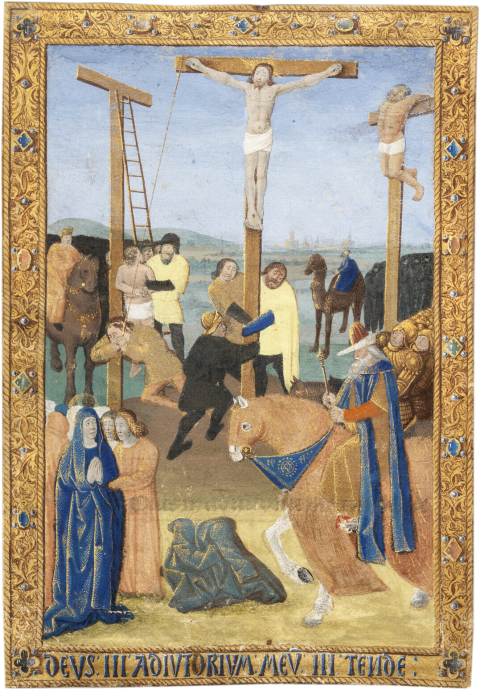


Jean Colombe (1430-1493)
, France, Bourges, c.1470–75Jean Colombe (1430-1493)
Description
This Crucifixion is a splendid example from among the most accomplished works of Jean Colombe. The discarded cloaks of the mourners in the foreground, the thief taken down from the cross, Pilate on horseback, the crowd of soldiers in the background, and the exotic camel all attest to the rich narrative so characteristic of Colombe’s works. The expansive landscape, receding in tones of pale blue, reveals towers of a town in the distant background. The miniature illustrates Sext from the Hours of the Cross from a Book of Hours, and its reverse includes the prayer at the end of Terce.
Only one other miniature is known from what must have been a richly illuminated Book of Hours. Today in the Musée du Louvre in Paris (Cabinet des dessins, RF54717), it portrays Christ before Pilate, at the beginning of Prime of the Hours of the Cross with its verso containing the conclusion of Matins. Not only do the two miniatures share a comparable palette and figure types, but they also display similar decorative jeweled borders and an opening text at the bottom of the sheet. In both cases the text, once placed in the lower quadrant of the miniature, has been painted over and moved to the lower edge of the parchment sheet, thus allowing for the expansion of the scene to occupy the entire page. A nearly identical jeweled border appears in the Bureau Hours (Paris, Drouot, November 14, 2023, lot. 88), and the use of text at the bottom of the page characterizes it and the Hours of Louis de Laval (Paris, Bibliothèque nationale de France, MS lat. 920), thus helping place our miniature as well as the sister leaf in the Louvre, in the early 1470s.
Illuminated with a complete cycle for the Hours of the Cross, in addition to the Hours of the Virgin and presumably other standard texts, the original manuscript must have had an extensive cycle of illuminations, along the lines of those in the Hours of Louis de Laval and the Bureau Hours. A miniature depicting the Flagellation or the Carrying of the Cross for the hour of Terce once separated the present miniature and the Louvre sheet, and the reverse of the Crucifixion contains the conclusion of the text for Terce. What happened to the parent manuscript? A nineteenth-century copy of our leaf by the well-known forger Caleb Wing offers a clue to its subsequent history (Fig. 7). When the library of John Boykett Jarman was damaged during a flash flood in London in 1843, Jarman retained Wing to restore (repaint) many of his manuscripts. François Avril has suggested that the parent manuscript of these two leaves was perhaps mostly destroyed in that flood, but that Wing, having access to all the manuscripts, copied the Crucifixion. Alas, this can only remain a tantalizing hypothesis since such a parent manuscript is not easily identifiable in the summary descriptions of the sale of the Jarman manuscripts in 1864.
provenance
? John Boykett Jarman (1782–1864);
Maggs Bros., Cat. 802, 1951, no 15 (ill.), priced £63; inscribed ‘£55’ in pencil on the reverse;
Alfred (1900–1965) and Felicie Amelie (Radziejewski) Scharf (1900–1991).
literature
Published:
Avril, François, Nicole Reynaud, and Dominique Cordellier. Les Enluminures du Louvre: Moyen Âge et Renaissance, Paris, 2011, no. 96, 192–94;
Related Literature:
Backhouse, Janet. “A Victorian Connoisseur and His Manuscripts: The Tale of Mr. Jarman and Mr. Wing.” In British Museum Quarterly 32 (1968):76–92.
Schaeffer, Claude. “Nouvelles observations au sujet des Heures de Louis de Laval.” In Arts de l’Ouest 1 (1980): 33–68.
Avril, François and Nicole Reynaud. Les manuscrits à peintures en France, 1440–1520. Paris, 1993, 328–32;
Avril, François. “Un tableau perdu de Fouquet et ses répliques enluminées.” In Art de l’Enluminure 87 (2023/2024): 14–25
learn
Jean Colombe, France, Bourges, active 1430-1493
Jean Colombe belonged to a prominent family of artists from Bourges, the chief town of the duchy of Berry. He was recorded there from 1463 until 1493, and he is believed to have lived and worked there continuously except for a few short periods. Nonetheless, neither his reputation nor his activity was restricted to his native city. He was patronized and protected by Charlotte of Savoy, queen of Louis XI and a noted bibliophile. He illuminated manuscripts for the queen, her daughter Anne of Beaujeu, and various members of the court. It was probably through Charlotte that Colombe was introduced into the service of her nephew, Charles I, Duke of Savoy, who retained him to complete two unfinished manuscripts in his library between 1485 and 1490: the splendid Apocalypse by Jean Bapteur and Perronet Lamy (Spain, El Escorial, E. Vit. 5) and, probably the most celebrated of all Books of Hours, the Limbourg brothers Très Riches Heures of the Duke of Berry (Chantilly, Musée Condé, MS 65). Among his other important commissions earlier in date is a Book of Hours for Louis de Laval (Paris, BnF, MS lat. 920) and the related Bureau Hours (Paris, Drouot, November 13, 2023, lot 88), both probably from the early 1470s. Colombe was commissioned to illustrate secular as well as religious texts and seems to have taken delight in providing scenes set within complex architecture or expansive landscapes and, wherever possible, containing crowds of onlookers. His narrative enthusiasm and invention were evidently keenly appreciated and, with the aid of his atelier including his sons Philibert and François, he decorated many manuscripts including some with the most ambitious of illustrative ensembles.